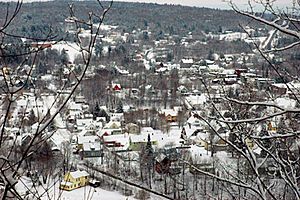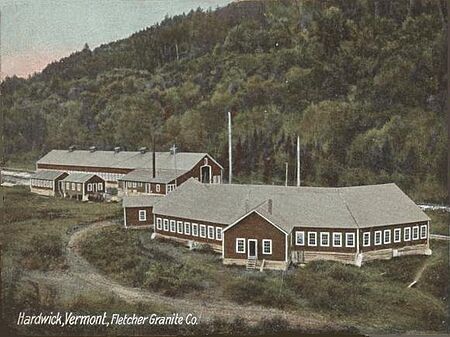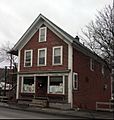Hardwick, Vermont facts for kids
Quick facts for kids
Hardwick, Vermont
|
|
|---|---|

North Main Street
|
|

Hardwick, Vermont
|
|
| Country | United States |
| State | Vermont |
| County | Caledonia |
| Chartered | 1781 |
| Communities | Hardwick East Hardwick Hardwick Center Hardwick Street Mackville |
| Area | |
| • Total | 39.0 sq mi (101.1 km2) |
| • Land | 38.6 sq mi (100.0 km2) |
| • Water | 0.4 sq mi (1.0 km2) |
| Elevation | 1,339 ft (408 m) |
| Population
(2020)
|
|
| • Total | 2,920 |
| • Density | 76/sq mi (29.2/km2) |
| Time zone | UTC-5 (Eastern (EST)) |
| • Summer (DST) | UTC-4 (EDT) |
| ZIP Codes |
05843 (Hardwick)
05836 (East Hardwick) |
| Area code(s) | 802 |
| FIPS code | 50-31825 |
| GNIS feature ID | 1462115 |
Hardwick is a town located in Caledonia County, Vermont, in the United States. In 2020, about 2,920 people lived there. The town includes smaller communities like Hardwick, East Hardwick, and Mackville. Hardwick is an important business hub for the farms in its area.
The main part of Hardwick, which used to be a village, is now called a census-designated place (CDP). In 2020, about 1,269 people lived in this central area.
Contents
History of Hardwick
Early Settlement and Growth
During the American Revolutionary War, General George Washington ordered a special road to be built. This road, called the Bayley-Hazen Military Road, helped people travel into Vermont. It also helped Hardwick and East Hardwick grow and become settled.
The town of Hardwick was officially created on November 7, 1780. It was then given a special document, called a charter, on August 19, 1781. This charter was given to Danforth Keyes and 66 other people. Some of these people came from a town called Hardwick, Massachusetts.
The first families to settle permanently in Hardwick arrived in 1793. They were named Norris and came from New Hampshire. By 1859, Hardwick had about 1,402 people. The town had many sawmills and gristmills along the Lamoille River. These mills used water power to cut wood and grind grain. There were also two places that made leather, called tanneries. Over time, other businesses started, like a factory that made wool cloth, a shop that made tin items, and a factory that built carriages.
The Granite Industry
After the American Civil War, the most important business in Hardwick was granite quarrying. Granite is a very hard stone used for building. This industry grew a lot when the Portland & Ogdensburg Railway built train tracks through the town. This made it easy to ship the heavy stone.
Most of the granite was dug up in nearby Woodbury. But the stone was shaped and finished in Hardwick. This work mostly happened near a place called "Granite Junction," where different train lines met. A special railroad, the Hardwick and Woodbury Railroad, was built just to bring granite from the quarries to the finishing shops. Because of all this activity, Hardwick became known as the "Building Granite Center of the World."
By 1906, about 1,200 people worked in the granite industry. The biggest company was the Woodbury Granite Company. Many famous buildings across the country were made with granite from Hardwick. These include the Pennsylvania State Capitol, Chicago City Hall, and the 1914 Post Office in Washington, D.C.. Many other city halls and custom houses also used Hardwick granite.
However, the demand for "architectural granite" started to go down in the 1920s and 1930s. This caused Hardwick to face tough economic times. In 1988, Hardwick Village joined with the larger town of Hardwick.
Geography of Hardwick
Hardwick is the westernmost town in Caledonia County. It shares borders with other towns. To the east are Walden and Stannard. To the north is Greensboro in Orleans County. To the west, in Lamoille County, are Wolcott and Elmore. To the south, in Washington County, are Woodbury and Cabot.
Hardwick covers a total area of about 101.1 square kilometers (39.0 square miles). Most of this is land, with about 1.0 square kilometer (0.4 square miles) being water. The main town center (CDP) is smaller, covering about 3.77 square kilometers (1.46 square miles).
The Lamoille River flows through Hardwick and its smaller streams. These waters eventually flow west into Lake Champlain. The highest point in Hardwick is the top of Jeudevine Mountain. It is about 558 meters (1,831 feet) above sea level.
Important roads that pass through Hardwick include Vermont Route 14, Vermont Route 15, and Vermont Route 16.
People of Hardwick (Demographics)
| Historical population | |||
|---|---|---|---|
| Census | Pop. | %± | |
| 1790 | 3 | — | |
| 1800 | 260 | 8,566.7% | |
| 1810 | 735 | 182.7% | |
| 1820 | 867 | 18.0% | |
| 1830 | 1,216 | 40.3% | |
| 1840 | 1,354 | 11.3% | |
| 1850 | 1,402 | 3.5% | |
| 1860 | 1,369 | −2.4% | |
| 1870 | 1,519 | 11.0% | |
| 1880 | 1,484 | −2.3% | |
| 1890 | 1,547 | 4.2% | |
| 1900 | 2,466 | 59.4% | |
| 1910 | 3,201 | 29.8% | |
| 1920 | 2,641 | −17.5% | |
| 1930 | 2,720 | 3.0% | |
| 1940 | 2,605 | −4.2% | |
| 1950 | 2,629 | 0.9% | |
| 1960 | 2,349 | −10.7% | |
| 1970 | 2,466 | 5.0% | |
| 1980 | 2,613 | 6.0% | |
| 1990 | 2,964 | 13.4% | |
| 2000 | 3,174 | 7.1% | |
| 2010 | 3,010 | −5.2% | |
| 2020 | 2,920 | −3.0% | |
| U.S. Decennial Census | |||
A census is a count of the population. In the 2000 census, there were 3,174 people living in Hardwick. These people lived in 1,216 households, and 854 of these were families. The town had about 82.4 people per square mile.
Most of the people in Hardwick (about 97.89%) were White. A small number of people were African American, Native American, Asian, or from other backgrounds. About 0.41% of the population was Hispanic or Latino.
About 37.8% of households had children under 18 living with them. About 52.1% were married couples. The average household had 2.61 people, and the average family had 3.06 people.
The population was spread out by age. About 29.5% were under 18 years old. About 28.9% were between 25 and 44 years old. The average age in Hardwick was 36 years.
Economy of Hardwick
Agriculture and Food Businesses
Hardwick has a growing number of businesses related to farming and food. These are called agribusinesses. Many of them use sustainable agriculture methods, which means they farm in ways that protect the environment. These businesses have created many new jobs in the area.
One important project is the Vermont Food Venture Center. This center helps new food businesses get started. It's like a shared kitchen and business helper for people who want to make special food products. This center is expected to create many full-time jobs once it is fully running.
Historic Places in Hardwick
Hardwick has five places that are listed on the National Register of Historic Places. This means they are important historical sites that are protected.
- Building at 143 Highland Avenue – This building is at 143 Highland Ave. (added May 6, 2000)
- Cobb School – This old school is at the corner of Hardwick Town Hwy. 10 (Cobb School Rd.) and Sanborn Cemetery Rd. (added October 30, 1993)
- Downtown Hardwick Village Historic District – This area includes Brush Street. (added April 10, 2004)
- Downtown Hardwick Village Historic District – This area includes Main, Church, Maple, and Mill Streets. (added October 30, 1982)
- Hardwick Street Historic District – This district is northeast of Hardwick. (added July 22, 1979)
Media in Hardwick
The Hardwick Gazette is a local newspaper that comes out every week. It started in 1889 and serves Hardwick and nine other nearby towns. As of 2016, about 2,200 copies were printed each week. The newspaper was even put up for sale through an essay contest! While the contest didn't get enough entries, a buyer was found from those who did enter. Ray Smalls bought the paper in February 2017. He has a business background and bought the paper with his wife.
Notable People from Hardwick
Many interesting people have come from Hardwick:
- Guy W. Bailey – He was the Secretary of State of Vermont and later the President of the University of Vermont.
- Dustin Grow Cheever – A politician.
- Catherine Cate Coblentz – A writer.
- Philip Cummings – A Spanish teacher, news analyst, and public speaker.
- Kent Osborne – A screenwriter and actor.
- Dorman Bridgman Eaton – A lawyer and author.
- Lee E. Emerson – He was the 69th governor of Vermont.
- Jim Fixx – An author who encouraged jogging.
- Thomas J. D. Fuller – A US congressman.
- David H. Nichols – A politician.
- William H. Taylor – An Associate Justice of the Vermont Supreme Court.
Images for kids
See also
 In Spanish: Hardwick (Vermont) para niños
In Spanish: Hardwick (Vermont) para niños











